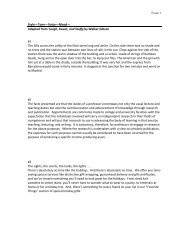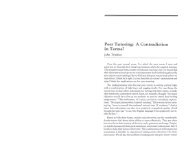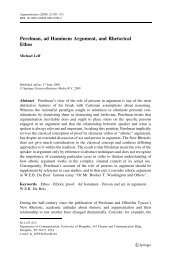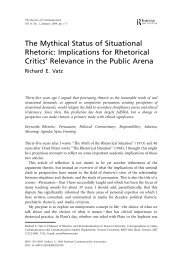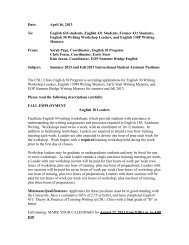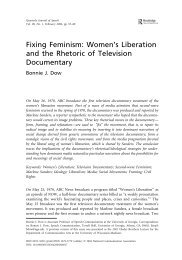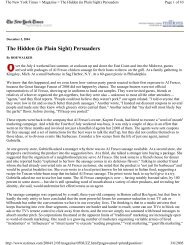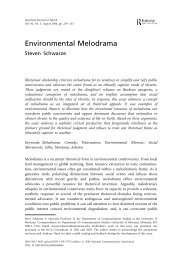Talking in the Middle: Why Writers Need Writing Tutors - CompHacker
Talking in the Middle: Why Writers Need Writing Tutors - CompHacker
Talking in the Middle: Why Writers Need Writing Tutors - CompHacker
Create successful ePaper yourself
Turn your PDF publications into a flip-book with our unique Google optimized e-Paper software.
<strong>Talk<strong>in</strong>g</strong> <strong>in</strong> <strong>the</strong> <strong>Middle</strong>: <strong>Why</strong> <strong>Writers</strong> <strong>Need</strong> Writ<strong>in</strong>g <strong>Tutors</strong>Author(s): Muriel HarrisReviewed work(s):Source: College English, Vol. 57, No. 1 (Jan., 1995), pp. 27-42Published by: National Council of Teachers of EnglishStable URL: http://www.jstor.org/stable/378348 .Accessed: 13/09/2012 13:04Your use of <strong>the</strong> JSTOR archive <strong>in</strong>dicates your acceptance of <strong>the</strong> Terms & Conditions of Use, available at .http://www.jstor.org/page/<strong>in</strong>fo/about/policies/terms.jsp.JSTOR is a not-for-profit service that helps scholars, researchers, and students discover, use, and build upon a wide range ofcontent <strong>in</strong> a trusted digital archive. We use <strong>in</strong>formation technology and tools to <strong>in</strong>crease productivity and facilitate new formsof scholarship. For more <strong>in</strong>formation about JSTOR, please contact support@jstor.org..National Council of Teachers of English is collaborat<strong>in</strong>g with JSTOR to digitize, preserve and extend access toCollege English.http://www.jstor.org
28 COLLEGE ENGLISH<strong>in</strong>habits a world somewhere between student and teacher. Because <strong>the</strong> tutor sitsbelow <strong>the</strong> teacher on <strong>the</strong> academic ladder, <strong>the</strong> tutor can work effectively withstudents <strong>in</strong> ways that teachers can not. <strong>Tutors</strong> don't need to take attendance, makeassignments, set deadl<strong>in</strong>es, deliver negative comments, give tests, or issue grades.Students readily view a tutor as someone to help <strong>the</strong>m surmount <strong>the</strong> hurdleso<strong>the</strong>rs have set up for <strong>the</strong>m, and as a result students respond differently to tutorsthan to teachers, a phenomenon readily noticed by tutors who end a st<strong>in</strong>t ofwrit<strong>in</strong>g center tutor<strong>in</strong>g and <strong>the</strong>n go off to teach <strong>the</strong>ir own classes. Dave Healy,who both tutors and teaches, aptly describes this scenario:In <strong>the</strong> center, writers may try to <strong>in</strong>vest me with authority, but I can resist <strong>the</strong>irefforts. In <strong>the</strong> classroom, I can try to resist, but as long as I'm go<strong>in</strong>g to be assign<strong>in</strong>gmy students grades, my nonauthoritative pose is simply that: a pose. In <strong>the</strong>classroom, I can't get away from mak<strong>in</strong>g assignments, and as long as I make <strong>the</strong>m,no matter how enlightened or open-ended <strong>the</strong>y may be, <strong>the</strong>y're still m<strong>in</strong>e. I cannever adopt <strong>the</strong> k<strong>in</strong>d of stance <strong>in</strong> relation to one of my assignments that I can <strong>in</strong>relation to an assignment that a writer br<strong>in</strong>gs to <strong>the</strong> center. And <strong>in</strong>creas<strong>in</strong>gly thatstance feels crucial to <strong>the</strong> k<strong>in</strong>d of work I want to do with writers.Most students come to writ<strong>in</strong>g centers because <strong>the</strong>y are required to (Bishop,Clark), but even so, students leave feel<strong>in</strong>g that <strong>the</strong> tutorial has been a beneficialexperience. <strong>Why</strong> is this so? The relationship with a tutor is likely to beg<strong>in</strong> withquestions like "How can I help you?" or "What would you like to work on today?"A truly reluctant student knows that she doesn't have to do anyth<strong>in</strong>g, won't begraded, and <strong>in</strong> a worst-case scenario, can silently count <strong>the</strong> cracks <strong>in</strong> <strong>the</strong> ceil<strong>in</strong>gwhile <strong>the</strong> tutor talks. But <strong>the</strong> vast majority of students start on a more positivenote. Here's someone who might just help <strong>the</strong>m, maybe even show <strong>the</strong>m what'swrong, what to fix, or what <strong>the</strong> writ<strong>in</strong>g assignment is about. As <strong>the</strong> conversationprogresses, <strong>the</strong>y beg<strong>in</strong> to talk more freely and more honestly because <strong>the</strong>y are not<strong>in</strong> <strong>the</strong> conf<strong>in</strong>es of a teacher/student relationship where <strong>the</strong>re are penalties forask<strong>in</strong>g what <strong>the</strong>y perceive as "dumb" questions (<strong>the</strong> penalty be<strong>in</strong>g that <strong>the</strong> teacherwill f<strong>in</strong>d out how little <strong>the</strong>y know or how <strong>in</strong>ept <strong>the</strong>y are <strong>in</strong> formulat<strong>in</strong>g <strong>the</strong>irquestions). Moreover, students realize that <strong>the</strong>y don't have to listen passively andaccept what is "told" to <strong>the</strong>m by an authoritative speaker.In addition to student attitudes toward tutors, ano<strong>the</strong>r powerful componentof <strong>the</strong> tutorial has to do with how tutors acquire needed <strong>in</strong>formation. Whereasteachers get <strong>in</strong>formation about students from conferences and from students'contributions to classroom <strong>in</strong>teraction, much of what's needed comes from <strong>the</strong>written products students turn <strong>in</strong>. And those products are often analyzed whenteachers are sitt<strong>in</strong>g alone at <strong>the</strong>ir desks, away from <strong>the</strong> students. By contrast, <strong>in</strong><strong>the</strong> <strong>in</strong>teraction between tutor and student, <strong>the</strong> tutor picks up clues from watch<strong>in</strong>gand listen<strong>in</strong>g to <strong>the</strong> student. <strong>Tutors</strong>' questions can lead students to offer <strong>in</strong>formation<strong>the</strong>y didn't know was needed and to clarify <strong>the</strong>ir answers through fur<strong>the</strong>r
WHY WRITERS NEED WRITING TUTORS 29question<strong>in</strong>g. Students can also offer o<strong>the</strong>r useful <strong>in</strong>formation <strong>the</strong>y would be lesswill<strong>in</strong>g to give teachers. Sitt<strong>in</strong>g with a student for a half-hour or an hour, a tutoris able to work primarily with <strong>the</strong> writer as a person, even when <strong>the</strong> paper is <strong>the</strong>reon <strong>the</strong> table between <strong>the</strong>m. <strong>Tutors</strong> use talk and question<strong>in</strong>g and all <strong>the</strong> cues <strong>the</strong>ycan pick up <strong>in</strong> <strong>the</strong> face-to-face <strong>in</strong>teraction. The conversation is free to roam <strong>in</strong>whatever direction <strong>the</strong> student and tutor see as useful. That is, <strong>the</strong> tutor can askabout writ<strong>in</strong>g habits and processes, can listen to <strong>the</strong> student's responses to variousquestions, and can use <strong>the</strong>m as cues for fur<strong>the</strong>r questions; and <strong>the</strong> student canexpress concerns not visible <strong>in</strong> <strong>the</strong> product. Moreover, ei<strong>the</strong>r one is free to br<strong>in</strong>gup some potentially relevant concern that takes <strong>the</strong>m off <strong>in</strong> a different, morefruitful direction. The flexibility and <strong>in</strong>teraction of a tutorial permits a close lookat <strong>the</strong> <strong>in</strong>dividual student, someth<strong>in</strong>g that Jim, a peer tutor <strong>in</strong> our Writ<strong>in</strong>g Lab,has noted. Jim spends one day a week <strong>in</strong> <strong>the</strong> classroom and <strong>the</strong>n works with thosestudents every week <strong>in</strong> tutorials. He notes that <strong>in</strong> <strong>the</strong> classroom his students area sea of "hands, faces, and comments," but when <strong>the</strong>se same students come to <strong>the</strong>Writ<strong>in</strong>g Lab, <strong>the</strong>y become very different <strong>in</strong>dividuals with dist<strong>in</strong>ct personalities,needs, and ways of learn<strong>in</strong>g. L<strong>in</strong>da Flower views teachers' "product-based <strong>in</strong>fer-ences" as a limitation that may radically underestimate students' knowledge,problem-solv<strong>in</strong>g efforts, and unresolved dilemmas. When that happens, notesFlower, teachers "may be try<strong>in</strong>g to diagnose and teach a th<strong>in</strong>k<strong>in</strong>g process <strong>in</strong> <strong>the</strong>dark" ("Study<strong>in</strong>g Cognition" 21). The face-to-face <strong>in</strong>teraction of tutor and studentpermits some light to enter.The power of <strong>the</strong> tutor's position outside <strong>the</strong> evaluative sett<strong>in</strong>g is alsoapparent <strong>in</strong> student evaluations that acknowledge tutors' expertise. There arealways impressively high rat<strong>in</strong>gs, positive comments, and effusive notes of appreciation,far beyond what any of us who also teach <strong>in</strong> classrooms will get when weswitch to wear<strong>in</strong>g our grade-giv<strong>in</strong>g-<strong>in</strong>structor hats. As tutors we are <strong>the</strong>re to helpreduce <strong>the</strong> stress, to overcome <strong>the</strong> hurdles set up by o<strong>the</strong>rs, and to know moreabout writ<strong>in</strong>g than a roommate or friend, maybe even as much as <strong>the</strong>ir teachers.Students may not have come will<strong>in</strong>gly and may (as is often <strong>the</strong> case) have comewith <strong>in</strong>appropriate expectations that <strong>the</strong> tutor will fix <strong>the</strong> paper or show <strong>the</strong>mwhat to do. Accord<strong>in</strong>gly, <strong>the</strong>y may <strong>in</strong>itially be irritated or unhappy that <strong>the</strong> tutor'srole is not to proofread <strong>the</strong> paper for <strong>the</strong>m or tell <strong>the</strong>m how to get a higher grade.But given a few m<strong>in</strong>utes of tutorial conversation, students beg<strong>in</strong> to see that <strong>the</strong>tutor can help <strong>the</strong>m learn how to proofread or how to fix <strong>the</strong>ir papers. Every tutorhas tales of students who turn sullen, morose, or even hostile when <strong>the</strong>y learn that<strong>the</strong> tutor isn't a free editor, but who eventually calm down and jo<strong>in</strong> <strong>in</strong> <strong>the</strong>conversation about strategies <strong>the</strong>y can use. At <strong>the</strong> end of such a tutorial, as <strong>the</strong>yare pack<strong>in</strong>g up, such students are apt to offer a "Hey, thanks a lot. That helped."Just as frequently, students who come <strong>in</strong> nervous, apprehensive, defeated, oreager to get any help <strong>the</strong>y can emerge from <strong>the</strong>ir sessions feel<strong>in</strong>g more positive,
30 COLLEGE ENGLISHmore <strong>in</strong> control of <strong>the</strong>ir own writ<strong>in</strong>g. The enormous power of <strong>the</strong>se positiveresponses to tutors cannot be overemphasized. Students may ignore <strong>the</strong> existenceof <strong>the</strong> center until required to come <strong>in</strong>, <strong>the</strong>y may come with all <strong>the</strong> wrongexpectations, and <strong>the</strong>ir attitudes toward writ<strong>in</strong>g may vary from anger to anxietyabout grades to eagerness to produce <strong>the</strong> best paper <strong>the</strong>y are capable of, but <strong>the</strong>vast majority emerge feel<strong>in</strong>g that <strong>the</strong> experience was positive. A number of usefulconsequences account for how tutors and students can work toge<strong>the</strong>r and whytutorial collaboration is different <strong>in</strong> k<strong>in</strong>d from <strong>the</strong> way students <strong>in</strong>teract with <strong>the</strong>irteachers.To illustrate this collaboration as well as to sh<strong>in</strong>e some light on what goes on<strong>in</strong> a tutorial, I will use not only language we are familiar with as teachers andscholars but also <strong>the</strong> language of students-who constitute a different though notentirely separate discourse community. The student comments are typical of <strong>the</strong>hundreds made each semester on evaluation forms that students attend<strong>in</strong>g ourWrit<strong>in</strong>g Lab are asked to fill out anonymously.ENCOURAGING INDEPENDENCE IN COLLABORATIVE TALK* I felt very comfortable with Pam. She helped me by mak<strong>in</strong>g me do <strong>the</strong> work. She let meth<strong>in</strong>k my problems through <strong>in</strong>stead of tell<strong>in</strong>g me what to do to correct my problems.* Richard is a great tutor. He helpsyou understand more whatyou're do<strong>in</strong>g by hav<strong>in</strong>gyoudo it yourself.* He let me decide everyth<strong>in</strong>g <strong>in</strong>stead of tell<strong>in</strong>g me what to change or do.* He made me th<strong>in</strong>k and realize more than <strong>in</strong> our class without tell<strong>in</strong>g me exactly how towrite.* These people know <strong>the</strong>ir stuffl But she didn'tjust give me answers. She got me th<strong>in</strong>k<strong>in</strong>g.* Colleen's tutorial style challenges you to th<strong>in</strong>k and re-th<strong>in</strong>k your material.* He made me teach myself He didn't tell me anyth<strong>in</strong>g.* She knows how to help without giv<strong>in</strong>g answers. She makes me th<strong>in</strong>k.* The help at <strong>the</strong> Writ<strong>in</strong>g Lab allows you to th<strong>in</strong>k on your own. He did not critique mypaper, but he asked me questions that made me see how to critique and th<strong>in</strong>k about myown paper.* I like how she wanted answers from me. She didn't just tell me what to do to makesometh<strong>in</strong>g right.A number of common threads tie <strong>the</strong>se comments toge<strong>the</strong>r. Students <strong>in</strong>sist that<strong>the</strong>y prefer to do <strong>the</strong>ir own work, come to <strong>the</strong>ir own conclusions, write what was<strong>in</strong> <strong>the</strong>ir own heads: <strong>the</strong>se students do not want to be told what to do. Cynics andnew tutors-<strong>in</strong>-tra<strong>in</strong><strong>in</strong>g may assume that most writers, when faced with turn<strong>in</strong>g <strong>in</strong>a paper, would probably be happiest if given directions for action. But this is not<strong>the</strong> case, as studies by Allen and by Walker and Elias have shown. Students wereasked to rate how satisfied <strong>the</strong>y were with tutorials <strong>in</strong> which <strong>the</strong> tutor ei<strong>the</strong>rassumed control and expla<strong>in</strong>ed what had to be done or used question<strong>in</strong>g that
WHY WRITERS NEED WRITING TUTORS 31permitted <strong>the</strong> student to th<strong>in</strong>k through <strong>the</strong> process and reach her own conclusions.From <strong>the</strong> students' perspectives, <strong>the</strong> more highly satisfactory tutorials werethose <strong>in</strong> which <strong>the</strong> students were active participants <strong>in</strong> f<strong>in</strong>d<strong>in</strong>g <strong>the</strong>ir own criteriaand solutions. Among <strong>the</strong> hundreds of completed forms that I read every semester,I can remember only one student compla<strong>in</strong>t about this approach: "All she didwas ask me questions." Given <strong>the</strong> student perception of a tutor as o<strong>the</strong>r than ateacher, we can see why students feel free from <strong>the</strong> classroom constra<strong>in</strong>t of hav<strong>in</strong>gto listen to <strong>the</strong> teacher and to do as <strong>the</strong>y are told. Even non-directive, studentcenteredteachers who see <strong>the</strong>ir advice and suggestions as open-ended possibilities<strong>the</strong>ir students can freely reject should recognize that such suggestions areoften not taken precisely as <strong>the</strong>y are <strong>in</strong>tended. Students feel freer to develop <strong>the</strong>irown ideas <strong>in</strong> sett<strong>in</strong>gs o<strong>the</strong>r than teacher/student conversations (and, of course,teacher comments on papers) and welcome <strong>the</strong> opportunity to have someone help<strong>the</strong>m sort through and formulate conceptual frameworks for drafts of <strong>the</strong>irpapers. Peer response groups may help, but a tutor who is tra<strong>in</strong>ed to ask prob<strong>in</strong>gquestions and who focuses her attention on <strong>the</strong> writer offers a more effectiveenvironment for <strong>the</strong> writer dur<strong>in</strong>g <strong>the</strong> generative stages of writ<strong>in</strong>g (Harris,"Collaboration"). It appears that writers both need and want discussion thatengages <strong>the</strong>m actively with <strong>the</strong>ir ideas through talk and permits <strong>the</strong>m to stay <strong>in</strong>control.A second strand <strong>in</strong> <strong>the</strong>se comments, <strong>the</strong> reiteration of <strong>the</strong> word "th<strong>in</strong>k,"<strong>in</strong>dicates that tutorial conversation differs from classroom discussion. As DouglasBarnes expla<strong>in</strong>s, tutorial or "exploratory" talk encourages th<strong>in</strong>k<strong>in</strong>g and discovery:Exploratory talk often occurs when peers collaborate <strong>in</strong> a task, when <strong>the</strong>y wish totalk it over <strong>in</strong> a tentative manner, consider<strong>in</strong>g and rearrang<strong>in</strong>g <strong>the</strong>ir ideas. The talkis often but not always hesitant, conta<strong>in</strong><strong>in</strong>g uncompleted or <strong>in</strong>explicit utterancesas <strong>the</strong> students try to formulate new understand<strong>in</strong>gs; exploratory talk enablesstudents to represent to <strong>the</strong>mselves what <strong>the</strong>y currently understand and <strong>the</strong>n ifnecessary to criticize and change it.... Presentational talk performs a differentand more public role. When students are called on <strong>in</strong> class, when <strong>the</strong>y feel to beunder evaluation, <strong>the</strong>y seldom risk exploration, but prefer to provide an acceptableperformance, a "right" answer. (50)I have italicized <strong>the</strong> word "evaluation" because it highlights <strong>the</strong> limitations ofclassroom discussion and teacher-student conferences. When talk<strong>in</strong>g with ateacher, most students will feel pressure to perform, to look as if <strong>the</strong>y're knowledgeable-<strong>in</strong>o<strong>the</strong>r words, to use presentational talk. Toss<strong>in</strong>g around ideas to seehow <strong>the</strong>y play out is more easily accomplished <strong>in</strong> a tutorial than <strong>in</strong> a teacher'sconference, and as Cynthia Onore po<strong>in</strong>ts out, exploratory language, though lesscontrolled and controll<strong>in</strong>g, has more power to generate confident assertions andmake connections than does presentational language. <strong>Tutors</strong> adept at <strong>the</strong> k<strong>in</strong>d ofcollaboration that encourages useful exploratory talk may guide <strong>the</strong> conversation,but <strong>the</strong>y do not <strong>in</strong>hibit <strong>the</strong> student. In students' perceptions, <strong>the</strong> person sitt<strong>in</strong>g
32 COLLEGE ENGLISHnext to <strong>the</strong>m is merely a tutor, someone to "help you br<strong>in</strong>g out your ideas." Inlight of current <strong>the</strong>ories of collaboration and social construction of knowledgethat,as Kenneth Bruffee states, "knowledge is an artifact created by a communityof knowledgeable peers and that learn<strong>in</strong>g is a social process not an <strong>in</strong>dividual one"(11)-we are less <strong>in</strong>cl<strong>in</strong>ed to see <strong>the</strong> result<strong>in</strong>g paper as conta<strong>in</strong><strong>in</strong>g only <strong>the</strong>student's ideas, but that is not <strong>the</strong> issue here. Gett<strong>in</strong>g <strong>the</strong> student engaged-trulyand actively engaged-is. Long before "empowerment" became a co<strong>in</strong> of <strong>the</strong>composition realm, tutors basked <strong>in</strong> <strong>the</strong> glow of hear<strong>in</strong>g students leave a tutorialsay<strong>in</strong>g, "OK, so now I know what I want to write. It was <strong>the</strong>re <strong>in</strong> my head, but Ijust couldn't get it out."ASSISTING WITH ACQUISITION OF STRATEGIC KNOWLEDGE* She made me th<strong>in</strong>k, didn't tell me what to do, just how to do it.* She helped me look at my paper from a different po<strong>in</strong>t of view. That helped a lot, and Iknow how to do that now.* I learned how to br<strong>in</strong>g out ideas by ask<strong>in</strong>g questions and what to do to develop <strong>the</strong>m.* The Writ<strong>in</strong>g Lab helped me see how to solve a problem <strong>in</strong>stead ofjust tell<strong>in</strong>g me what'swrong.* I learned how to organize my paper. It was hard to see how to do that with all <strong>the</strong> notesI collected from my library search<strong>in</strong>g.* I learned to discuss what I want to say and how to go about do<strong>in</strong>g that.* I expla<strong>in</strong>ed my organizational problems, and she was able to help me revise my paperwithout do<strong>in</strong>g it for me, giv<strong>in</strong>g me skills to connect with o<strong>the</strong>r papers I may write.* This makes me focus on how I write.* I wanted to structure my paper but I didn't get exactly how I could do this. She helpedme see how, and now I know I can write <strong>the</strong> paper I am capable of writ<strong>in</strong>g.* I didn't see how I was caus<strong>in</strong>g myself problems with my writ<strong>in</strong>g. She really helped mesee how to do it better for <strong>the</strong> way that I write.<strong>Writers</strong> need several types of knowledge, some more easily ga<strong>in</strong>ed <strong>in</strong> <strong>the</strong> classroomand o<strong>the</strong>rs more appropriately acquired <strong>in</strong> <strong>the</strong> one-to-one sett<strong>in</strong>g of atutorial. If Barnes shows us why tutorial talk encourages know<strong>in</strong>g, Louise Phelpstells us what k<strong>in</strong>ds of knowledge are needed: propositional and procedural. Onek<strong>in</strong>d of knowledge, that which she identifies as propositional knowledge, is<strong>the</strong>oretical. It consists of know<strong>in</strong>g about a set of possibilities for action but doesnot help us know how to act, for as Phelps says, "<strong>the</strong>ory can never tell peopledirectly what to do" because <strong>the</strong>oretical knowledge does not embed with<strong>in</strong> itselfrules for how to apply it (863). Such knowledge is general and not tied to <strong>the</strong><strong>in</strong>dividual. Phelps expla<strong>in</strong>s that much of what is given <strong>in</strong> textbooks and lecturesis formal knowledge <strong>in</strong> which know<strong>in</strong>g is learn<strong>in</strong>g to name concepts and toarticulate <strong>the</strong>ir relationships (870). By contrast, practical know<strong>in</strong>g-<strong>the</strong> knowl-
WHY WRITERS NEED WRITING TUTORS 33edge of <strong>the</strong> practitioner-arises out of <strong>the</strong> <strong>in</strong>dividual's recognition of a set ofpossibilities for actions, <strong>in</strong>ternalized images, descriptions, and prescriptions.Textbooks and classroom discussions can build this k<strong>in</strong>d of practical knowledgebut not <strong>the</strong> second k<strong>in</strong>d of practical knowledge that Phelps identifies. This secondk<strong>in</strong>d of practical knowledge is know<strong>in</strong>g from personal experience how to act, <strong>in</strong><strong>the</strong> sense of possess<strong>in</strong>g a habit or skill for perform<strong>in</strong>g an activity. For example,students may th<strong>in</strong>k <strong>the</strong>y know how to bra<strong>in</strong>storm an idea or argument, but onlywhen sitt<strong>in</strong>g with a student can a tutor help <strong>the</strong> student see how it feels to turnoff that <strong>in</strong>ternal editor, which rejects avenues of thought before <strong>the</strong>y are fullyexplored, or how to take bra<strong>in</strong>storm<strong>in</strong>g notes before an idea evaporates frommemory or how to let threads of an argument or analogy cont<strong>in</strong>ue to play<strong>the</strong>mselves out <strong>in</strong> various directions. A student who began a tutorial compla<strong>in</strong><strong>in</strong>gthat he doesn't know what else to add to a paper that's too short is likely toprogress from answer<strong>in</strong>g a tutor's questions to offer<strong>in</strong>g some suggestions tograbb<strong>in</strong>g a sheet of paper and forgett<strong>in</strong>g that <strong>the</strong>re is a tutor sitt<strong>in</strong>g next to himas he works through a more extended reason for support<strong>in</strong>g (or reject<strong>in</strong>g) electioncampaign reform. The student beg<strong>in</strong>s to learn "how it feels" to do this. An evenmore concrete example is <strong>the</strong> student who learns how to proofread for spell<strong>in</strong>g,miss<strong>in</strong>g words, or typos. Such a student may have come to <strong>the</strong> writ<strong>in</strong>g centerknow<strong>in</strong>g <strong>in</strong> some general sense what proofread<strong>in</strong>g is but not know<strong>in</strong>g what it feelslike to pace oneself very slowly or to focus on words one by one.Help<strong>in</strong>g students get <strong>the</strong> "feel" of some aspects of writ<strong>in</strong>g is part of what atutor can do as she sits next to <strong>the</strong> student, talk<strong>in</strong>g, model<strong>in</strong>g, and offer<strong>in</strong>gsuggestions, even though writ<strong>in</strong>g is a more sophisticated activity than any of<strong>the</strong>se. <strong>Tutors</strong> can help students learn how to proofread, how to let go and bra<strong>in</strong>storm,how to capture a flood of ideas <strong>in</strong> <strong>the</strong> plann<strong>in</strong>g stage, how to take all thosescraps of paper and note cards and organize <strong>the</strong>m, how to <strong>in</strong>sert revisions <strong>in</strong>to atext, how to draw back and figure out if <strong>the</strong> organizational structure is appropriate,or how to check on paragraph development. If needed, a tutor can model a processor can watch <strong>the</strong> student as she goes through a process herself (Harris, "Model<strong>in</strong>g"),look<strong>in</strong>g for what is work<strong>in</strong>g appropriately and what might be done moreeffectively <strong>in</strong> a different way. Or a tutor can suggest a few possible strategies, anyone of which might be more appropriate for this particular writer who writes <strong>in</strong>his or her particular way. This may seem obvious because it is what tutors oftendo <strong>in</strong> a tutorial, but it can startle a student as he suddenly "sees" what he'ssupposed to do <strong>in</strong> order to achieve whatever it was he was try<strong>in</strong>g to achieve.This recognition of possible strategies is part of what L<strong>in</strong>da Flower <strong>in</strong>cludes<strong>in</strong> <strong>the</strong> k<strong>in</strong>ds of knowledge writers need. Such knowledge, she expla<strong>in</strong>s, "<strong>in</strong>volvesread<strong>in</strong>g a situation and sett<strong>in</strong>g appropriate goals, hav<strong>in</strong>g <strong>the</strong> knowledge and strategiesto meet one's own goals, and f<strong>in</strong>ally, hav<strong>in</strong>g <strong>the</strong> metaknowledge of awareness
34 COLLEGE ENGLISHto reflect on both goals and strategies. Strategic knowledge is a contextualizedform of know<strong>in</strong>g; it develops over time and out of experience" ("Study<strong>in</strong>g Cognition"23). Similarly, Alred and Thelen recognize <strong>the</strong> need for strategic knowledge:"We know <strong>in</strong>tuitively that teach<strong>in</strong>g students to write requires much morethan teach<strong>in</strong>g a canon of rules; it requires that we enable students to rehearse avariety of strategies" (471). The rehearsal by some students may go well on <strong>the</strong>irown, but it may not for o<strong>the</strong>rs. That rehearsal enacted with a tutor watch<strong>in</strong>g andoffer<strong>in</strong>g feedback and advice is a particularly effective tutorial practice. Strategiesare easy to learn <strong>in</strong> an environment where <strong>the</strong> person next to <strong>the</strong> writer cananswer questions as <strong>the</strong> writer proceeds and can offer some midstream correctionor encouragement when someth<strong>in</strong>g is not go<strong>in</strong>g well. Flower's strategic knowledgeis that form of procedural knowledge, or know<strong>in</strong>g how, that Phelps describes,and Flower also notes that writers should have optional strategies <strong>in</strong> <strong>the</strong>irrepertoire for different tasks and different purposes ("Negotiat<strong>in</strong>g AcademicDiscourse" 245). When know<strong>in</strong>g-<strong>in</strong>-action, as Phelps calls it (873), bogs downand doesn't work, <strong>the</strong> writer needs what Phelps calls "reflection-<strong>in</strong>-action" andwhat Flower po<strong>in</strong>ts to when she <strong>in</strong>sists on <strong>the</strong> writer's need for metacognitiveawareness of <strong>the</strong> acts of sett<strong>in</strong>g goals and <strong>in</strong>vok<strong>in</strong>g strategies ("Negotiat<strong>in</strong>gAcademic Discourse" 222). Learn<strong>in</strong>g how to view what has been done, ga<strong>in</strong><strong>in</strong>g<strong>the</strong> high ground, is yet ano<strong>the</strong>r task <strong>the</strong> tutor can assist with. In <strong>the</strong> tutorialconversation <strong>the</strong> tutor helps <strong>the</strong> student recognize what's go<strong>in</strong>g on and how totalk about it as well as how to act. Although tutors often help with propositionalknowledge-for example, knowledge of various academic genres of writ<strong>in</strong>g,knowledge of rhetorical structures, or knowledge of cultural variations <strong>in</strong> rhetoricalvalues that perplex <strong>in</strong>ternational students-<strong>the</strong> art of <strong>the</strong> tutor is to collaboratewith students as <strong>the</strong>y acquire <strong>the</strong> practical knowledge <strong>the</strong>y need.ASSISTING WITH AFFECTIVE CONCERNS* I learned my paper wasn't as bad as I thought it was. It's easier to do a good job whenyou don't th<strong>in</strong>k your writ<strong>in</strong>g's terrible.* I like <strong>the</strong> atmosphere. I can ask my questions here, and I learned some techniques toovercome writ<strong>in</strong>g anxiety.* They treat you as equals. It is not like teachers help<strong>in</strong>g students. This makes <strong>the</strong> studentfeel more at ease.* Ifyou have a block, as I did on how to write a paper, <strong>the</strong> tutor will help you rememberwhat you have learned <strong>in</strong> <strong>the</strong> past.* She talked to me with an accept<strong>in</strong>g attitude even though my paper was shaky. Sheworked with me, and not like she was over me.* I'm try<strong>in</strong>g to overcome my fear of writ<strong>in</strong>g, and this is <strong>the</strong> place to be.* He helped me sort through my lack ofconfidence.
WHY WRITERS NEED WRITING TUTORS 35* I am less stressed about my paper because I actually know what I am try<strong>in</strong>g to say now.* She was easy to talk to. I could ask questions without feel<strong>in</strong>g stupid.* She was patient and gave me confidence. I needed to be conv<strong>in</strong>ced that I was approach<strong>in</strong>gmy paper correctly.No one doubts that student writers too often lack confidence <strong>in</strong> <strong>the</strong>ir skills or that<strong>the</strong>y f<strong>in</strong>d writ<strong>in</strong>g to be an anxiety-produc<strong>in</strong>g task, but <strong>the</strong> classroom teachercannot attend to <strong>the</strong> variety of worries that <strong>in</strong>hibit some student writers. Thosefears range from evaluation anxiety to long-stand<strong>in</strong>g reluctance to have a teacher"bleed all over" <strong>the</strong>ir papers, from writ<strong>in</strong>g blocks of various levels of <strong>in</strong>tensity todefeatist convictions that <strong>the</strong>y are not good writers. In tutorials students oftenunburden <strong>the</strong>mselves and f<strong>in</strong>d a sympa<strong>the</strong>tic ear as well as some suggestions forgett<strong>in</strong>g past <strong>the</strong>ir affective concerns. As I read evaluations every semester, itappears that tutorial assistance gives students confidence about <strong>the</strong>mselves and<strong>the</strong>ir writ<strong>in</strong>g. The word "confidence" repeats itself so often that I have askedstudents to talk about why <strong>the</strong>y feel more confident after talk<strong>in</strong>g with a tutor.Typically <strong>the</strong> response is that a student <strong>in</strong>itially feels unsure that a paper meets anassignment or is well written. When a tutor helps <strong>the</strong> writer set up criteria to usefor her own assessment, <strong>the</strong> writer ga<strong>in</strong>s confidence <strong>in</strong> decid<strong>in</strong>g whe<strong>the</strong>r <strong>the</strong>paper is ready to be turned <strong>in</strong>. Or <strong>the</strong> tutor can give <strong>the</strong> writer some readerresponse that helps her see what needs more clarification. <strong>Tutors</strong> can also helpwhen students worry that <strong>the</strong>ir mental representation of what <strong>the</strong>y wanted towrite does not sufficiently overlap <strong>the</strong> product that actually appears on paper.Help<strong>in</strong>g writers match <strong>in</strong>tention or plan with <strong>the</strong> written result is often a usefulexercise, particularly s<strong>in</strong>ce tutors often f<strong>in</strong>d that <strong>the</strong> writer's mental representationis far richer than <strong>the</strong> less impressive draft. Ask<strong>in</strong>g <strong>the</strong> writer somequestions or request<strong>in</strong>g more details often results <strong>in</strong> <strong>the</strong> writer's see<strong>in</strong>g what elsehe should have <strong>in</strong>cluded or where (or how) <strong>the</strong> paper drifted away from <strong>the</strong><strong>in</strong>tended goal. After such sessions, students talk about "feel<strong>in</strong>g better" about <strong>the</strong>irpapers or know<strong>in</strong>g what else <strong>the</strong>y want to do when <strong>the</strong>y revise. It appears fromsome evaluations that <strong>the</strong>ir newly found confidence also results <strong>in</strong> strongermotivation. While <strong>the</strong> role of motivation <strong>in</strong> language learn<strong>in</strong>g has not been amajor topic of composition research, tutors recognize that deal<strong>in</strong>g with affectiveconcerns and offer<strong>in</strong>g encouragement result <strong>in</strong> <strong>in</strong>creased motivation to cont<strong>in</strong>ueexpend<strong>in</strong>g effort on a paper.Ano<strong>the</strong>r affective concern reflected <strong>in</strong> student comments is that it is stressfulfor <strong>the</strong>m to talk about <strong>the</strong>ir writ<strong>in</strong>g with someone whom <strong>the</strong>y perceive as hav<strong>in</strong>gsome <strong>in</strong>stitutional authority over <strong>the</strong>m. Such students view <strong>the</strong>mselves as be<strong>in</strong>gtreated as <strong>in</strong>feriors, talked down to, demeaned <strong>in</strong> some way when talk<strong>in</strong>g withteachers, but not with tutors. The collaborative atmosphere of <strong>the</strong> tutorial, <strong>the</strong>sense of be<strong>in</strong>g with someone who does not assume any authoritative posture,
3 6 COLLEGE ENGLISHseems to relieve that stra<strong>in</strong> or elim<strong>in</strong>ate <strong>the</strong> fear. It is undoubtedly true that someteachers do re<strong>in</strong>force <strong>the</strong> stereotypical authoritarian stance or aren't as adept as<strong>the</strong>y might be <strong>in</strong> us<strong>in</strong>g language that <strong>the</strong>ir students understand. But it would beworth <strong>in</strong>vestigat<strong>in</strong>g whe<strong>the</strong>r students' perceptions of teachers' roles <strong>in</strong> some waycreate <strong>in</strong> some students <strong>the</strong> belief that <strong>the</strong>y have been reduced to an <strong>in</strong>feriorstance or treated as a lower form of life. Though teachers may well seek <strong>the</strong> samecollegial tone as tutors, some students cannot see <strong>the</strong> similarity because <strong>the</strong>yexpect <strong>the</strong>ir teachers to perceive <strong>the</strong>m as <strong>in</strong>feriors. The power structure ofacademia may rema<strong>in</strong> <strong>in</strong>tact <strong>in</strong> part because some students perpetuate it <strong>in</strong> <strong>the</strong>irown m<strong>in</strong>ds. There may also be a language issue here, <strong>the</strong> issue of differentdiscourse communities, as discussed below.INTERPRETING THE MEANING OF ACADEMIC LANGUAGE* He helped me understand my profs mean<strong>in</strong>g.* She expla<strong>in</strong>ed what needed to be done <strong>in</strong> language that I understood.* I got <strong>in</strong>-depth explanations of handouts given <strong>in</strong> class. I didn't understand <strong>in</strong> class withjust <strong>the</strong> teacher's explanations.* You do a fantastic job with help<strong>in</strong>g students understand what to do with an assignment.I had <strong>in</strong>terpreted it <strong>in</strong> a way that was not correct.* Now I know how to write an expressive paper. I was off course before.* I was hav<strong>in</strong>g a problem see<strong>in</strong>g what cont<strong>in</strong>uity was.* We worked on what is a letter to an editor. This is not someth<strong>in</strong>g I learned to do <strong>in</strong> mycountry.* Thanks. You helped me see what my teacher wants me to do when I revise.* She answered all my questions about what response writ<strong>in</strong>g is. I got <strong>the</strong> help I needed.* The prof couldn't expla<strong>in</strong> what I needed to know, but thanks to L<strong>in</strong>da, I understandnow.A cursory read<strong>in</strong>g of <strong>the</strong>se student comments would be that <strong>the</strong>y are prais<strong>in</strong>gtutors for be<strong>in</strong>g able to expla<strong>in</strong> better than teachers, but a more appropriateanalysis might be that <strong>the</strong>se students are report<strong>in</strong>g that <strong>the</strong> tutor <strong>in</strong>terpretedteacher language by translat<strong>in</strong>g it <strong>in</strong>to <strong>the</strong>ir language, that is, gave mean<strong>in</strong>g toterms <strong>the</strong>y had heard and read and not understood. Just as Phelps po<strong>in</strong>ts out thatpractitioner teachers cannot easily translate <strong>the</strong>ir problems <strong>in</strong>to <strong>the</strong> critical discourseof <strong>the</strong>ory (863), student writers cannot easily translate <strong>the</strong>ir problems <strong>in</strong>to<strong>the</strong> discourse of composition or make mean<strong>in</strong>g of <strong>the</strong> language about writ<strong>in</strong>g.When students recognize problems, <strong>the</strong>y normally do not have <strong>the</strong> metaknowledgethat Flower says is needed or <strong>the</strong> necessary metalanguage to locate <strong>the</strong>appropriate section of a textbook, ask a teacher, or tell a tutor. Students com<strong>in</strong>gto a writ<strong>in</strong>g center do not-most often cannot-say <strong>the</strong>y want to work on<strong>in</strong>vention strategies or sharpen <strong>the</strong>ir focus or improve <strong>the</strong> coherence of a paper.
WHY WRITERS NEED WRITING TUTORS 37They come <strong>in</strong> say<strong>in</strong>g that <strong>the</strong>y "need help" or that <strong>the</strong> paper "doesn't flow." It iseven more likely that <strong>the</strong>y give <strong>the</strong> paper to <strong>the</strong> tutor, hop<strong>in</strong>g <strong>the</strong> tutor can givenames to <strong>the</strong>ir <strong>in</strong>ternal sense that someth<strong>in</strong>g is needed. Student language is not<strong>the</strong> language we use. Mary Louise Pratt observes that students and teachers<strong>in</strong>habit separate communities, though she acknowledges that <strong>the</strong>re is hardly totalhomogeneity <strong>in</strong> ei<strong>the</strong>r <strong>the</strong> teacher community or student community. Pratt's<strong>in</strong>terest is <strong>in</strong> gett<strong>in</strong>g us to move away from view<strong>in</strong>g groups as exist<strong>in</strong>g separately,a view that gives rise to a l<strong>in</strong>guistics that seeks to capture <strong>the</strong> identity but not <strong>the</strong>relationality of social differentiation. But, she expla<strong>in</strong>s, dom<strong>in</strong>ant and dom<strong>in</strong>atedgroups are not comprehensible apart from each o<strong>the</strong>r, for <strong>the</strong>ir speech practicesare organized to enact <strong>the</strong>se differences and <strong>the</strong>ir hierarchy. Any dom<strong>in</strong>atedgroup is required simultaneously to identify with and disassociate itself from <strong>the</strong>dom<strong>in</strong>ant group.Students' discourse consequently is both dist<strong>in</strong>ct from and permeated by thatof teachers, <strong>the</strong> dom<strong>in</strong>ant group. Pratt offers <strong>the</strong> <strong>in</strong>terest<strong>in</strong>g suggestion that <strong>the</strong>rebe a "l<strong>in</strong>guistics of contact" (60), which studies <strong>the</strong> operation of language acrossl<strong>in</strong>es of differentiation, focus<strong>in</strong>g on <strong>the</strong> nodes and zones of contact betweengroups. S<strong>in</strong>ce tutors live <strong>in</strong> this contact zone somewhere between teachers andstudents, tutorial talk may be a particularly fruitful area <strong>in</strong> which to research whatthose nodes and zones are.That teachers view <strong>the</strong>mselves as set apart and different from <strong>the</strong>ir studentsis apparent from Cheryl Towns's study of how members of <strong>the</strong> compositionprofession refer to students when writ<strong>in</strong>g articles <strong>in</strong> <strong>the</strong> pages of College Compositionand Communication. In <strong>the</strong> n<strong>in</strong>eteen articles she analyzed, Towns found thatstudents were referred to often, over 345 times, with <strong>the</strong> highest frequencycharacteriz<strong>in</strong>g <strong>the</strong>m as "mere fledgl<strong>in</strong>gs," new and <strong>in</strong>experienced, novices, learners.Much of <strong>the</strong> language was about relationships between teachers and students,and <strong>the</strong> most prevalent category was "teacher as teacher" and "student as student,"despite comments <strong>in</strong> <strong>the</strong> same articles which deplored this traditionalrelationship. The metaphors used were often of see<strong>in</strong>g, gett<strong>in</strong>g students "to see,""to observe," and teachers were perceived as givers with students as receivers orteachers as leaders and students as followers. Towns concluded that "though wemay be beg<strong>in</strong>n<strong>in</strong>g to see <strong>the</strong> need to move beyond <strong>the</strong> traditional power structureof <strong>the</strong> classroom, we are still deeply entrenched <strong>in</strong> it" (97).<strong>Tutors</strong> are thus o<strong>the</strong>r than teachers <strong>in</strong> that <strong>the</strong>y <strong>in</strong>habit a middle groundwhere <strong>the</strong>ir role is that of translator or <strong>in</strong>terpreter, turn<strong>in</strong>g teacher language <strong>in</strong>tostudent language. "Focus," "coherence," and "development" are not terms asreadily understood by students as teachers th<strong>in</strong>k. As a result, a common tutorialtask is help<strong>in</strong>g <strong>the</strong> student understand <strong>the</strong> comments a teacher has made on apaper, thus confirm<strong>in</strong>g <strong>the</strong> results of a study by Mary Hayes and Donald Daikerwhich vividly demonstrates how little of what teachers write <strong>in</strong> <strong>the</strong> marg<strong>in</strong>s of
38 COLLEGE ENGLISHpapers is understood <strong>in</strong> any useful way. Similarly, Jill Burkland and Nancy Grimmnote: "Through our experiences as tutors <strong>in</strong> our university's Writ<strong>in</strong>g Center andthrough years <strong>in</strong> <strong>the</strong> composition classroom, we were aware that teachers' <strong>in</strong>tentionsare often unrealized, that written communication on papers is often misunderstoodor mis<strong>in</strong>terpreted by students" (237-38). O<strong>the</strong>r studies report similarconclusions <strong>in</strong> tones of defeat and discouragement. As Knoblauch and Brannonnote, "The depress<strong>in</strong>g trouble is, we have scarcely a shred of empirical evidenceto show that students typically even comprehend our responses to <strong>the</strong>ir writ<strong>in</strong>g,let alone use <strong>the</strong>m purposefully to modify <strong>the</strong>ir practice" (1). Similarly, <strong>in</strong> alarge-scale study that looked at teacher comments, Robert Connors and AndreaLunsford found a portrait of teachers hav<strong>in</strong>g little time and less faith that <strong>the</strong>ircomments would be understood.Students' difficulties <strong>in</strong> understand<strong>in</strong>g teacher comments are partly thisdifference <strong>in</strong> vocabulary, but <strong>the</strong>re is also <strong>the</strong> problem of students' perception ofteacher <strong>in</strong>tent beh<strong>in</strong>d <strong>the</strong> comments. When a paper is returned with numerousteacher responses, some students may read <strong>the</strong> marg<strong>in</strong>alia and end comments;most don't. They skip down to <strong>the</strong> grade and wander <strong>in</strong>to <strong>the</strong> writ<strong>in</strong>g centerassum<strong>in</strong>g that <strong>the</strong> teacher didn't like <strong>the</strong>ir writ<strong>in</strong>g. For too many students, <strong>the</strong><strong>in</strong>tent of a teacher's comments is "to rip my writ<strong>in</strong>g," "to bleed all over my paper,"or "to cut me to shreds." Suggestions, notes of encouragement, and even praiseare not always noted by student writers. A large number of comments "means"(from <strong>the</strong> student's perception) that <strong>the</strong> teacher didn't like <strong>the</strong> paper, and soano<strong>the</strong>r tutorial task is to help students read and <strong>in</strong>terpret teacher response <strong>in</strong> adifferent light, not entirely as criticism but as <strong>in</strong>clud<strong>in</strong>g well-mean<strong>in</strong>g suggestions.For example, a student who came to our Writ<strong>in</strong>g Lab had a paper with <strong>the</strong>follow<strong>in</strong>g comment: "What is <strong>the</strong> thread of connection here to your explanationon page 7-that such cultural practices provoke <strong>in</strong>terfamily rivalry?" While <strong>the</strong>teacher was suggest<strong>in</strong>g some potentially <strong>in</strong>terest<strong>in</strong>g connections for <strong>the</strong> writer toexplore, <strong>the</strong> writer read that as a comment on her failure to see <strong>the</strong> connectionherself. She needed a tutor to help <strong>in</strong>terpret <strong>the</strong> <strong>in</strong>tent of that message just aso<strong>the</strong>r students need tutors to help <strong>the</strong>m understand <strong>the</strong> mean<strong>in</strong>g of o<strong>the</strong>r k<strong>in</strong>dsof teacher language. It is certa<strong>in</strong>ly not <strong>the</strong> case that all written response fails orthat all students draw a complete blank when seek<strong>in</strong>g to comprehend <strong>the</strong> importof those comments. Some response gets through, but <strong>in</strong>stead of beat<strong>in</strong>g ourbreasts and assum<strong>in</strong>g guilt by failure or tak<strong>in</strong>g such f<strong>in</strong>d<strong>in</strong>gs as <strong>in</strong>dictments ofteachers, we need to recognize <strong>the</strong> reality of language users <strong>in</strong> different groupsstra<strong>in</strong><strong>in</strong>g across chasms to hear each o<strong>the</strong>r. If we accept differences <strong>in</strong> languagecommunities as realities, <strong>the</strong>n we can view <strong>the</strong> writ<strong>in</strong>g center as <strong>the</strong> <strong>in</strong>stitutionalizedmechanism to facilitate <strong>the</strong> flow of o<strong>the</strong>rwise impeded communication.It follows from this problem of different languages that students often don'tunderstand <strong>the</strong>ir assignments (which are, after all, written by teachers, not stu-
WHY WRITERS NEED WRITING TUTORS 39dents). Misunderstand<strong>in</strong>g <strong>the</strong> assignment happens with such astonish<strong>in</strong>g regularitythat we ought more properly to view it as part of <strong>the</strong> educational processlearn<strong>in</strong>g<strong>the</strong> language of academic communities, learn<strong>in</strong>g how to understand thatlanguage, and learn<strong>in</strong>g how to act on that understand<strong>in</strong>g. John Ackerman, us<strong>in</strong>grestra<strong>in</strong>t <strong>in</strong> report<strong>in</strong>g on <strong>the</strong> f<strong>in</strong>d<strong>in</strong>gs of an extensive research project, notes that"<strong>in</strong> many cases <strong>the</strong> assignment given by an <strong>in</strong>structor and <strong>the</strong> assignment takenby a student are not a reciprocal fit" (96). Because students often need help <strong>in</strong>learn<strong>in</strong>g how to <strong>in</strong>terpret <strong>the</strong>se writ<strong>in</strong>g assignments, it is a frequent topic oftutorial collaboration. An assignment to "<strong>in</strong>terpret" a passage <strong>in</strong> a literary workis as confus<strong>in</strong>g to some students as an assignment to "<strong>in</strong>terpret" read<strong>in</strong>gs <strong>in</strong>current health care economics is to o<strong>the</strong>r students. O<strong>the</strong>r students are overwhelmedby "analyze and compare" assignments or unable to figure out how torespond to what Louise Z. Smith calls a "bewilder<strong>in</strong>g array of heuristics" <strong>in</strong>complex assignments with multiple prompts (465). In composition courses as wellas writ<strong>in</strong>g-across-<strong>the</strong>-curriculum courses, students may be unable to plunge <strong>in</strong>,stymied by an <strong>in</strong>ability to figure out what <strong>the</strong> assignment is ask<strong>in</strong>g for. "Weworked on improv<strong>in</strong>g his understand<strong>in</strong>g of <strong>the</strong> assignment" is perhaps one of <strong>the</strong>most common summaries of tutorial sessions <strong>in</strong> writ<strong>in</strong>g centers. Some studentsrecognize <strong>the</strong>ir difficulties with this and come to <strong>the</strong> center ask<strong>in</strong>g that <strong>the</strong> tutorread <strong>the</strong> paper to see if it meets <strong>the</strong> assignment; o<strong>the</strong>rs come with a draft ask<strong>in</strong>g,"Am I on <strong>the</strong> right track?" Such students are nei<strong>the</strong>r stupid nor lazy-<strong>the</strong>y arebe<strong>in</strong>g honest <strong>in</strong> acknowledg<strong>in</strong>g that <strong>the</strong>y don't have a clear idea of what <strong>the</strong>assignment is or whe<strong>the</strong>r <strong>the</strong>y have managed to write a paper that lands somewhere<strong>in</strong> <strong>the</strong> right ballpark. The tutor's task is to help <strong>the</strong> student see how herlong, impassioned narrative of <strong>the</strong> emotional stresses and stra<strong>in</strong>s on her familydur<strong>in</strong>g a divorce does not meet <strong>the</strong> assignment to "take a stance on a currentsocietal issue and defend it." Flower sees <strong>the</strong> frequent tendency to misunderstandor mis<strong>in</strong>terpret assignments <strong>in</strong> terms of <strong>the</strong> <strong>in</strong>dividual differences students br<strong>in</strong>gto <strong>the</strong> classroom:Students hold some significantly different, tacit representations of supposedlycommon academic tasks. Because <strong>the</strong>se multifaceted mental representationsare constructed from prior experience, from <strong>in</strong>ferences about <strong>the</strong> social and rhetoricalcontext, and from writers' own values and desires, students may approacha common read<strong>in</strong>g-to-write assignment with mean<strong>in</strong>gfully different sets of goals,strategies, and criteria.... These differences can cause problems. Because <strong>the</strong>serepresentations are often tacit, students and teachers may be <strong>in</strong> unspoken disagreementabout what constitutes an "appropriate" representation. ("Study<strong>in</strong>g Cognition"21)Yet despite <strong>the</strong>se differences, says Flower, classroom syllabi assume a homogeneitythat doesn't exist, a "one size fits all" situation ("Study<strong>in</strong>g Cognition" 22).Individual differences as well as language confusions must have an appropriate
40 COLLEGE ENGLISHsett<strong>in</strong>g <strong>in</strong> which <strong>the</strong>y can be tended to when <strong>the</strong> need arises, and <strong>the</strong> writ<strong>in</strong>gcenter is that place.To compound <strong>the</strong> problem of <strong>the</strong> need for <strong>in</strong>dividualized attention to differences<strong>in</strong> student representations of task assignments, we have to be aware thatstudents are also not always well versed <strong>in</strong> <strong>the</strong> shift<strong>in</strong>g conventions <strong>in</strong> variousk<strong>in</strong>ds of academic discourse. An eng<strong>in</strong>eer<strong>in</strong>g student may need help <strong>in</strong> understand<strong>in</strong>gwhy his nuclear eng<strong>in</strong>eer<strong>in</strong>g report was graded down ("lacks conciseness")for hav<strong>in</strong>g <strong>the</strong> k<strong>in</strong>d of extended <strong>in</strong>troductory paragraph that earned A's <strong>in</strong>his freshman composition course. The student who wrote objective problemstatements <strong>in</strong> her research reports for computer science classes doesn't understand<strong>the</strong> need for some subjectivity <strong>in</strong> writ<strong>in</strong>g <strong>the</strong> problem identification sectionof a research report on a controversial environmental policy <strong>in</strong> which she has todefend or refute an issue. One <strong>in</strong>structor may view a nurs<strong>in</strong>g student's cl<strong>in</strong>icalknowledge as acceptable support; ano<strong>the</strong>r may require <strong>the</strong> writer to support thatknowledge by cit<strong>in</strong>g published research. In <strong>the</strong> writ<strong>in</strong>g center this means help<strong>in</strong>g<strong>the</strong> writer articulate what <strong>the</strong> problem is. The tutor may assist <strong>in</strong> identify<strong>in</strong>gwhich conventions and rules <strong>the</strong> writer is work<strong>in</strong>g with and when <strong>the</strong> writer hasto return to <strong>the</strong> content teacher for clarification. Occasionally students appearwith personal sets of half-understood suggestions that have become rigid and<strong>in</strong>appropriate rules (Harris, "Contradictory Perceptions"; Rose); at o<strong>the</strong>r times,as Terese Thonus has shown us, students learn<strong>in</strong>g English as a second languageneed particular help thread<strong>in</strong>g <strong>the</strong>ir way through <strong>the</strong> multiple messages, differentcriteria, and differ<strong>in</strong>g standards <strong>the</strong>y encounter <strong>in</strong> academia.When Gerald Alred and Erik Thelen note that writ<strong>in</strong>g "is bound up withcreativity, cognition, language formation, personality, and social <strong>in</strong>teraction"(471), <strong>the</strong>ir list nicely captures <strong>the</strong> sense of a mix of <strong>in</strong>ternal variations amongwriters as well as <strong>the</strong> outside forces that play upon writers and <strong>the</strong>ir texts. Situatedas <strong>the</strong>y are to work one-to-one with each writer and his or her needs, tutors canattend to <strong>in</strong>dividual differences. Equally important, as students repeatedly tell us<strong>in</strong> <strong>the</strong>ir evaluation comments, tutors work with <strong>the</strong>m <strong>in</strong> ways that enable andencourage <strong>in</strong>dependent th<strong>in</strong>k<strong>in</strong>g and that help <strong>the</strong>m see how to put <strong>the</strong>ir <strong>the</strong>oreticalknowledge <strong>in</strong>to practice as <strong>the</strong>y write. Moreover, tutorial <strong>in</strong>teraction helpswriters ga<strong>in</strong> confidence <strong>in</strong> <strong>the</strong>mselves as writers by attend<strong>in</strong>g to <strong>the</strong>ir affectiveconcerns and assists <strong>the</strong>m <strong>in</strong> learn<strong>in</strong>g what academic language about writ<strong>in</strong>gmeans. Writ<strong>in</strong>g centers may still have to contend with a dim<strong>in</strong>ish<strong>in</strong>g m<strong>in</strong>oritywho view <strong>the</strong>m as unnecessary frills, suck<strong>in</strong>g up funds, space, and personnel toduplicate what goes on <strong>in</strong> <strong>the</strong> classroom or to coddle remedial students whoshouldn't have been admitted <strong>in</strong> <strong>the</strong> first place, but as we turn our attention to<strong>the</strong> work of <strong>the</strong> tutor, we become <strong>in</strong>creas<strong>in</strong>gly aware that writ<strong>in</strong>g <strong>in</strong>structionwithout a writ<strong>in</strong>g center is only a partial program, lack<strong>in</strong>g essential activitiesstudents need <strong>in</strong> order to grow and mature as writers.
WHY WRITERS NEED WRITING TUTORS 41WORKSCITEDAckerman, John. "Students' Self-Analysis and Judges' Perceptions: Where DoThey Agree?" In Read<strong>in</strong>g-to-Write: Explor<strong>in</strong>g a Cognitive and Social Process.Ed. L<strong>in</strong>da Flower et al. 96-111.Allen, Nancy. "Develop<strong>in</strong>g an Effective Tutorial Style." Writ<strong>in</strong>g Lab Newsletter15.3 (November 1990): 1-4.Alred, Gerald, and Erik Thelen. "Are Textbooks Contributions to Scholarship?"College Composition and Communication 44.4 (December 1993): 466-77.Barnes, Douglas. "Oral Language and Learn<strong>in</strong>g." In Perspectives on Talk andLearn<strong>in</strong>g. Ed. Susan Hynds and Donald Rub<strong>in</strong>. 41-54.Bishop, Wendy. "Br<strong>in</strong>g<strong>in</strong>g <strong>Writers</strong> to <strong>the</strong> Center: Some Survey Results, Surmises,and Suggestions." Writ<strong>in</strong>g Center Journal 10.2 (Spr<strong>in</strong>g/Summer 1990): 31-44.Bruffee, Kenneth. "Peer Tutor<strong>in</strong>g and <strong>the</strong> 'Conversation of Mank<strong>in</strong>d."' In Writ<strong>in</strong>gCenters: Theory and Adm<strong>in</strong>istration. Ed. Gary Olson. Urbana: NCTE, 1984. 3-15.Burkland, Jill, and Nancy Grimm. "Motivat<strong>in</strong>g through Respond<strong>in</strong>g." Journal ofTeach<strong>in</strong>g Writ<strong>in</strong>g 5 (1986): 237-47.Clark, Irene. "Lead<strong>in</strong>g <strong>the</strong> Horse: The Writ<strong>in</strong>g Center and Required Visits."Writ<strong>in</strong>g Center Journal 5.2/6.1 (Spr<strong>in</strong>g/Summer 1985; Fall/W<strong>in</strong>ter 1985):31-34.Connors, Robert, and Andrea Lunsford. "Teachers' Rhetorical Comments onStudent Papers." College Composition and Communication 44.2 (May 1993):200-23.Flower, L<strong>in</strong>da. "Negotiat<strong>in</strong>g Academic Discourse." In Read<strong>in</strong>g-to-Write: Explor<strong>in</strong>ga Cognitive and Social Process. Ed. L<strong>in</strong>da Flower et al. 221-52.. "Study<strong>in</strong>g Cognition <strong>in</strong> Context." In Read<strong>in</strong>g-to-Write: Explor<strong>in</strong>g a Cognitiveand Social Process. Ed. L<strong>in</strong>da Flower et al. 3-32.Flower, L<strong>in</strong>da, et al. Read<strong>in</strong>g-to-Write: Explor<strong>in</strong>g a Cognitive and Social Process.New York: Oxford UP, 1990.Harris, Muriel. "Collaboration Is Not Collaboration Is Not Collaboration."College Composition and Communication 43.1 (February 1992): 369-83.-- . "Contradictory Perceptions of Rules of Writ<strong>in</strong>g." College Composition andCommunication 30.2 (May 1979): 218-20.--. "Model<strong>in</strong>g: A Process Method of Teach<strong>in</strong>g." College English 45.1 (January1983): 74-84.Hayes, Mary H., and Donald Daiker. "Us<strong>in</strong>g Protocol Analysis <strong>in</strong> Evaluat<strong>in</strong>g Responsesto Student Writ<strong>in</strong>g." Freshman English News 13.2 (Fall 1984): 1-4, 10.Healy, Dave. "late night talk." Post<strong>in</strong>g to <strong>the</strong> WCenter electronic bullet<strong>in</strong> board,13 May 1993.
42 COLLEGE ENGLISHHynds, Susan, and Donald Rub<strong>in</strong>, eds. Perspectives on Talk and Learn<strong>in</strong>g. Urbana:NCTE, 1990.Knoblauch, C. H., and Lil Brannon. "Teacher Commentary on Student Writ<strong>in</strong>g."Freshman English News 10 (1981): 1-4.Onore, Cynthia. "Negotiation, Language, and Inquiry: Build<strong>in</strong>g Knowledge Col-laboratively <strong>in</strong> <strong>the</strong> Classroom." In Perspectives on Talk and Learn<strong>in</strong>g. Ed. SusanHynds and Donald Rub<strong>in</strong>. 57-72.Phelps, Louise We<strong>the</strong>rbee. "Practical Wisdom and <strong>the</strong> Geography of Knowledge<strong>in</strong> Composition." College English 53.8 (December 1991): 863-85.Pratt, Mary Louise. "L<strong>in</strong>guistic Utopias." In L<strong>in</strong>guistics of Writ<strong>in</strong>g: Argumentsbetween Language and Literature. Ed. Nigel Fabb. New York: Methuen, 1987.48-66.Rose, Mike. "Rigid Rules, Inflexible Plans, and <strong>the</strong> Stifl<strong>in</strong>g of Language: ACognitivist Analysis of Writer's Block." College Composition and Communication31.4 (December 1980): 389-401.Smith, Louise Z. "Compos<strong>in</strong>g Composition Courses." College English 46.5 (September1984): 460-69.Thonus, Terese. "<strong>Tutors</strong> as Teachers: Assist<strong>in</strong>g ESL/EFL Students <strong>in</strong> <strong>the</strong> Writ<strong>in</strong>gCenter." Writ<strong>in</strong>g Center Journal 13.2 (Spr<strong>in</strong>g 1993): 13-26.Towns, Cheryl Hofstetter. "Dumbo or Colleague? Our Professional Perceptionsof Students." Composition Studies/Freshman English News 21.1 (Spr<strong>in</strong>g 1993):94-103.Walker, Carolyn, and David Elias. "Writ<strong>in</strong>g Conference Talk: Factors Associatedfor High- and Low-Rated Writ<strong>in</strong>g Conferences." Research <strong>in</strong> <strong>the</strong> Teach<strong>in</strong>g ofEnglish 21.3 (1987): 226-85.



